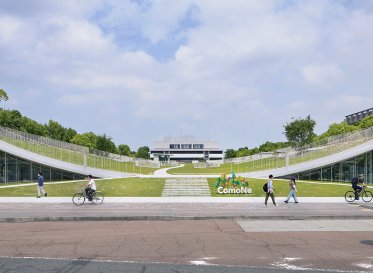
Designing SHIBUYA QWS, A Co-Creation Base That Creates Social Value Through “Questions”
Outline
Shibuya Scramble Square, the 47-floor skyscraper directly connected to and above Shibuya Station in Tokyo, opened in November 2019. The company operating the complex, Shibuya Scramble Square Corporation, wanted to create an incubation facility within that embodied the uniqueness of Shibuya and share the variety of values with society. To achieve this, the company partnered with Loftwork, which has an extensive track record in designing co-creation spaces and community management to build SHIBUYA QWS, a brand new co-creation space and industrial exchange facility, short for “Question With Sensibilities.”
The QWS project began in August 2016 as a joint project between Tokyu, JR East and Tokyo Metro. Loftwork, along with other partners, first worked on spatial design before forming a joint project team with Shibuya Scramble Square to carry out the preparations for the opening of QWS, including business planning, concept development, brand design, space and interior design, service and operation design and communication design, in addition to other preparations.
Over the course of one year and 10 months, people from a wide range of fields such as business, science, art, design and social activities gathered to learn from each other and work organically to create a co-creation center that would generate new ideas and businesses that will provide social value.

Project Outline
- Project Name:SHIBUYA QWS Launch Project
- Project period:December 2018 – October 2019
- Organization
- Overall supervision:Yukio Nomura (SCSQ)
- Project Management Officer (PMO): Chiaki Hayashi
- Project Management: Yuki Takai, Emi Hirata (SCSQ)
- Creative Direction: Reine Yamada, Satoki Nagatani, Ryo Kanazashi, Kanako Yasumoto
- Producers: Hajime Matsui, Mari Ishida
- Space Direction: Hajime Matsui, Akari Miyamoto,
- Satoshi Morikawa (SCSQ)
- Space Design: Tomoji Ohno (DOMINO ARTCHITECTS)
- Community design, space operation design: Akari Miyamoto
- Program design: Emi Hirata (SCSQ)
- Communication Strategy: Hiroyuki Watanabe (SCSQ), Atsuko Hirobe (SCSQ)
- Concept making, copywriting: Seiya Munakata (White Note Co., Ltd.)
- Graphic Design: Ken Okamoto (Ken Okamoto Design Office Inc.)
- Tool design: Masanori Matsui (METER inc.)
- Web design: Panorama Inc.
- Web coding and implementation: Takuma Design Inc.
- Video production: EANAME Inc.
- Costume design and production: Citatel Corporation
(Titles are as of the time of the project.)
SCSQ: Shibuya Scramble Square Co.
Challenge
Launching an incubation space directly above Shibuya Station to generate new social value to share with the world
QWS is a membership-based co-creation space that creates value from 0 → 1 in fields such as business, science, art, culture and societal issues, while placing “questions” at the core of everything. The essence of the business was not to be an office space to be rented out but to become an updated version of an incubation facility.
The challenge in launching the QWS business lay in how to build an ecosystem that could continuously create value while also drawing from the benefits of the geographical advantages of Shibuya, where people, information and goods come and go quickly in large numbers. The project team aimed to create a community to sustain a state – defined as a “scramble society” – where creative and diverse small groups could gather, organically react to each other and work in friendly competition. The concept, space, brand, communication and services were designed in an integrated manner.

Outputs
Concept

Communication Design
The project team defined unique graphic elements for QWS to ensure that all communication from QWS shared a likeness.
The graphic elements consist of partially trimmed elements of the letters “Q,” “W,” “S,” and “?”, reflecting the variability and diversity of QWS and the diverse image of Shibuya. After cutting out and recombining patterns from the graphic elements, the team developed them into a whole range of communication tools, from web design to printed materials such as posters, pamphlets and business cards, as well as presentation slides.



Space
Designing a space where diverse projects can mix and stimulate each other
We implemented eight spaces with different purposes and expressions, including an open workspace that creates horizontal connections, an event hall that can accommodate 200 people, a salon space where members can chat with guests and a town hall that serves as a nexus that connects all spaces with each other.
From solo work to group work, large conferences to salons, the flexible spaces accommodate the needs of diverse project teams, promote co-creation and provide support for QWS members.





Tool Design
Creating a special experience through the smallest details
From a playbook that provides a friendly introduction to the concept of QWS and how to utilize the facility to various items that prompt people to explore the theme of “questions”, the project team designed a variety of tools to create an experience unique to QWS, a members-only facility.



Story
A community concept that puts ‘questions’ at its core
The facility’s name originates from the phrase “question with sensibility,” and the key phrase embodies the activities that occur within.
We believe that exploring the essence of things and constantly asking questions is the starting point that leads to new value, so we decided to name the facility SHIBUYA QWS, an acronym for “Question With Sensibility”.
– From “What is SHIBUYA QWS?”
When verbalizing the existence of QWS, it was necessary to convey that it is a new center creates and transmits a wide range of “new values” to the world through the interaction of the adventurous spirit of entrepreneurs, the intelligence of the five universities QWS collaborates with, social and cultural activities and the diverse culture of Shibuya.
In order to do this, the project team came up with personas for QWS members. They defined a “member” as someone who participated in the community with their own “questions”. The concept of QWS was defined as “a crossroads of possibilities that asks questions from Shibuya to the world” and the vision as “creating social impact and movements that change the world”.
The mission of QWS is to discover and solve essential problems from a long-term perspective through the “Scramble Society” that it has created and to foster the creative human resources that will lead the future.

Value creators and supporters
Service design according to the way members relate to each other
The main goal for the team was to design services for a membership facility that generates diverse values and gathers various creative, small projects, as well as companies and organizations that value these activities and want to support them.
Therefore, QWS’ service for general members – both QWS members and QWS project members – was to provide individuals and small groups working in the fields of science, art, design, social activities and business with a space and “project base” for their activities. It also operates as a community to promote its members’ activities.
In addition, QWS also collaborates with external groups from universities in Tokyo – the University of Tokyo, Tokyo Institute of Technology, Keio University, Waseda University, and Tokyo City University – in order to stimulate intellectual exchange among groups. It also works with NPOs engaged in cultural and artistic activities, venture capitalists, and other external organizations to host events, seminars, study groups, workshops and open calls for projects.
For corporations, the team designed the “QWS Corporate Members” program, which allows corporations to discover new businesses through co-creation, support QWS members who are creating value and to develop their own human resources using the QWS programs.
The team also set up the “QWS Commons” membership program for leading players in various fields to share their experience and skills through mentoring, networking introductions and financial support.
Through the various spaces and membership schemes, the team laid the groundwork for members to meet people they never would have, allowing them to stimulate each others’ creativity and collaborate on new and diverse projects.
Next Contents















